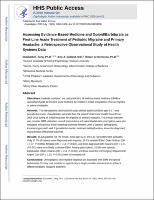Please use this identifier to cite or link to this item:
https://hdl.handle.net/20.500.12202/10099| Title: | Assessing evidence-based medicine and opioid/barbiturate as first-line acute treatment of pediatric migraine and primary headache: A retrospective observational study of health systems data |
| Authors: | Seng, Elizabeth K. Gelfand, Amy A. Nicholson, Robert A 0000-0002-8938-4949 |
| Keywords: | Migraine -- Drug Therapy Analgesics, Opioid -- Administration and Dosage Barbiturates -- Administration and Dosage Migraine -- Diagnosis Medical Practice, Evidence-Based -- Methods Medical Practice, Evidence-Based -- Trends Retrospective Design Headache -- Epidemiology Female; Adolescence Male Treatment Outcomes Time Factors Headache -- Drug Therapy Migraine -- Epidemiology Headache -- Diagnosis Child Funding Source |
| Issue Date: | Jul-2019 |
| Publisher: | SAGE |
| Citation: | Seng, E. K., Gelfand, A. A., & Nicholson, R. A. (2019). Assessing evidence-based medicine and opioid/barbiturate as first-line acute treatment of pediatric migraine and primary headache: A retrospective observational study of health systems data. Cephalalgia, 39(8), 1000-1009. |
| Series/Report no.: | Cephalalgia;39(8) |
| Abstract: | Objectives: To evaluate providers' use and predictors of evidence-based medicine or opioid/barbiturate as first-line acute treatment for children's initial presentation of acute migraine or primary headache.Methods: This retrospective, observational study utilized patient (children ages 6-17) and provider/encounter characteristics extracted from the patient's Electronic Health Record from 2008-2014 during an initial encounter for migraine or primary headache. The primary outcome was provider evidence-based medicine utilization; overall prescriptions and opioid/barbiturate prescriptions were also evaluated. Hierarchical linear modeling examined whether Level 1 (patient: Demographic, insurance type) and Level 2 (provider/encounter: Treatment setting/location, encounter diagnoses) characteristics influenced outcomes.Results: In all, 38,926 patients (56.7% female, mean age = 12.1) and 1617 providers were evaluated. Only 17.7% of patients were diagnosed with migraine; 16.1% received evidence-based medicine. Older children (OR = 1.07, p < 0.001), females (OR = 1.14, p < 0.001), and those diagnosed with migraine (OR = 4.71, p < 0.001) were more likely to receive evidence-based medicine. Among prescriptions, 15.8% were for opioids/barbiturates. Older children (OR = 1.14, p < 0.001) and those cared for in the emergency department/urgent care (OR = 2.02, p < 0.001) were at increased risk.Conclusions: Demographics and migraine diagnosis are associated with evidence-based medicine and opioid/barbiturates. Primary care provides an opportunity to target provider interventions to enhance effective pediatric headache treatment. |
| Description: | Scholarly article / Open access |
| URI: | https://hdl.handle.net/20.500.12202/10099 |
| ISSN: | 0333-1024 |
| Appears in Collections: | Ferkauf Graduate School of Psychology: Faculty Publications |
Files in This Item:
| File | Description | Size | Format | |
|---|---|---|---|---|
| Seng 2019 OA Assessing evidence-based.pdf | 487.24 kB | Adobe PDF |  View/Open |
This item is licensed under a Creative Commons License

